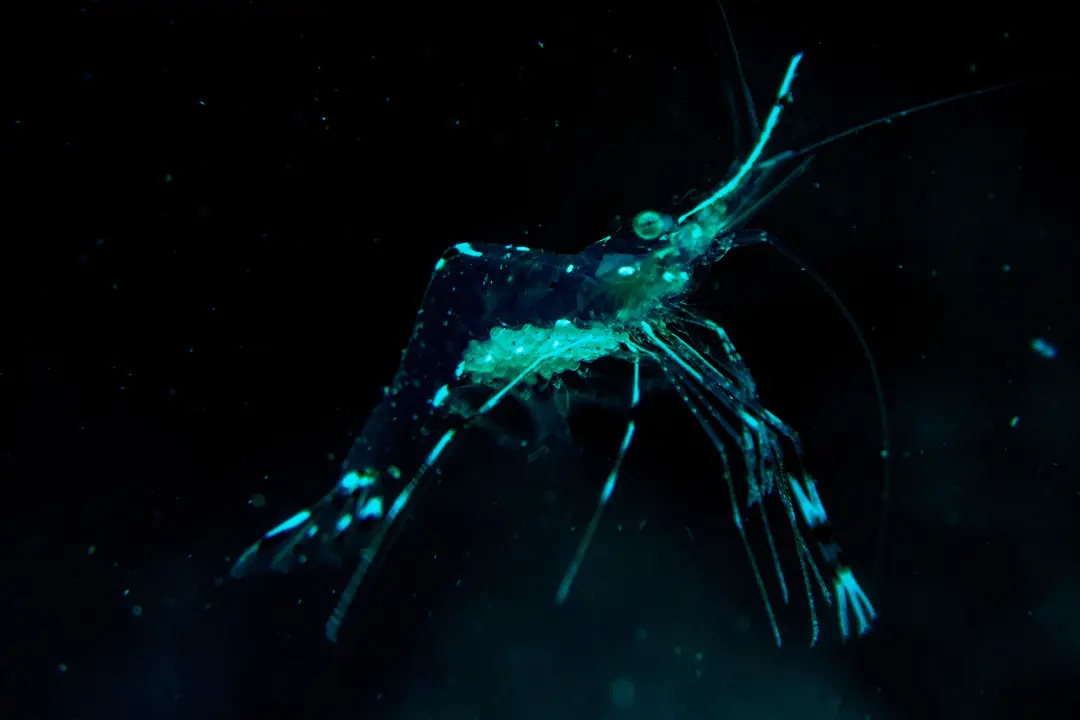Choosing the right ghost shrimp food can be difficult. If you already have the ghost shrimp in your aquarium or wish to add one, you have come to the right place. Today, we discuss what to feed ghost shrimp for a healthy lifestyle. Along with that, some essential care tips for ghost shrimp.
Let me ask you this: Have you ever wondered what delights tickle your shrimpie’s taste buds? What do ghost shrimp eat? Well, sit back and relax as we explore all you need to know about your shrimpy pet’s appetite and care.
Here is some of the best food for a ghost shrimp diet
- shrimp pellets
- Fresh vegetables
- frozen vegetables
- Live invertebrates like
- frozen invertebrate foods
Your pet shrimp will surely delight in these options. But if you’d like to add something extraordinary to its diet plan, consider our expert opinion given below. Get ready to make waves in the world of aquatic cuisine!
Ghost Shrimp Diet
It’s not as hard as it seems. Ghost shrimps are omnivores, which means they are not picky eaters. They eat both plants and animals. However, providing a balanced diet is very important for their proper nutrition.
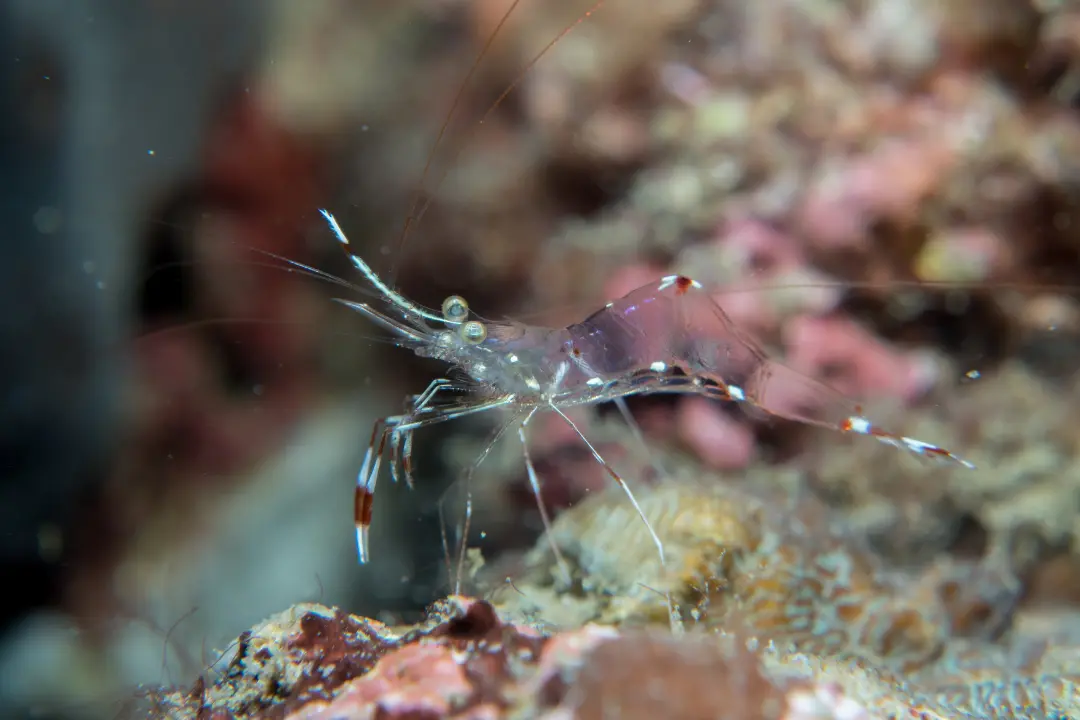
Usually, algae wafers and fish flakes are a go-to food for ghost shrimp and are easy to find in the market. They also like Vegetables like zucchini and spinach. however, the vegetables should be blanched. You can also try adding live frozen brine shrimp, blood worms, and small crustaceans to the ghost shrimp diet. Here are some of the best ghost shrimp foods
- Hikari Tropical Shrimp Cuisine Fish Food
- sera Shrimps Nature 1.9 oz 100 ml
- Dennerle Shrimp King Complete Sticks Food
providing a mixed menu will fulfill the required nutrition. We suggest, maintaining a proper timetable for their diet. Monitoring their eating habits will help as well. Proper nutrition and consistency are essential for maintaining the ideal ghost shrimp diet.
Understanding Ghost Shrimp
Ghost shrimp are fascinating creatures originating from freshwaters of North America. These translucent creatures have almost clear bodies. As the name suggests, they look like ghosts due to their see-through bodies. They are also known as glass shrimps.
The ghost shrimps might look delicate but they are hardy creatures. They can adapt to many conditions however, they like to thrive in freshwaters with lots of hiding spaces. Lastly, Their small body size makes them ideal for freshwater and community tanks.

Ghost Shrimp Size & Appearance
Wondering: How big does a ghost shrimp get ? Ghost shrimps reach a full length of 1.5 inches. But the body size varies with age. These small creatures reach a width of about 0.5 inches. Overall, they have thin, pencil-like bodies. However, the females tend to be larger than the males.
They have slight hues on their body, like faint hints of color and specks of black. This adds to the beauty of this wonderous freshwater marvel. Moreover, their bodies are in segments. They have a noticeable abdomen, a tapered tail, and a distinguished hump, midway on their tail. Overall, this beautiful creature can help you keep the tank clean but in return, you would have to provide the perfect ghost shrimp diet!

Ghost Shrimp Antenna: The Secret Weapon
This shrimp has got it all! beauty with brains has a smart way of sensing its surroundings. The ghost shrimp has a pair of long slender antennas used for navigation. In addition to that, they have small, paddles called swimmerets. The swimmerets help them in movement and balance.
They also have a pair of small antennas that assist them as well. Between the eyes is the most clear part where the internal working can be seen. When you feed it, look at the shrimp up close as its internal organs can be seen moving. Moreover, long clear legs are attached to the dorsal side of the shrimp. These legs help the shrimp to walk when scavenging for food.
Cut to, the ghost shrimp has an intriguing appearance and adds to the ecosystem by cleaning extra algae. This makes them ideal aquarium pets for novice and expert aquarists.
Ghost Shrimp as Tank Cleaners
You must be wondering: do ghost shrimp eat algae ? Yes! They eat algae. Along with their intriguing looks, they also add to the ecosystem. They love algae! this makes them natural algae eaters. Their peaceful nature and cleaning habits make them a sage for the tank. These shrimps will take care of your aquarium when you aren’t around. So, it’s best to add some shrimps to your aquarium but consider their compatibility with the tankmates first.
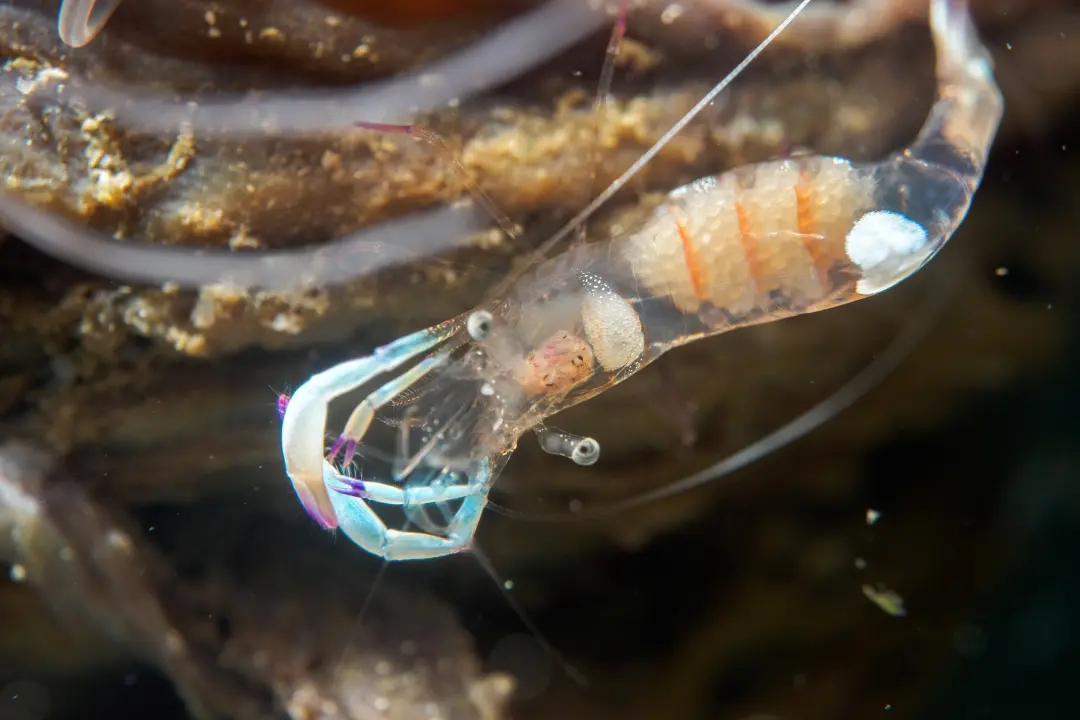
More Food for Ghost Shrimp
If you are wondering what else you can add to the ghost shrimp diet. You can add protein-rich foods like the following can delight little shrimpy
- daphnia
- Mysis shrimp
- Cyclops
- Grindal worms
- Mosquito larvae
- shrimp pellets
- spinach
- zucchini
- peas
- daphnia
- bloodworms
- brine shrimp

These live and frozen foods will fulfill your ghost shrimp’s nutritional needs. Moreover, commercial shrimp palettes and boiled eggs can be a treat. Adding calcium-rich aquarium shrimp food is beneficial for maintaining the shrimp’s exoskeleton. Some of our top suggestions for calcium-rich foods include
- crushed coral
- cuttlebone
- Calcium-enriched algae wafers
- Blanched zucchini
Additionally, kale and spinach should be added to the shrimp’s diet. This will provide the shrimp with the necessary vitamins and minerals to thrive in the tank.
Summing that up, to make sure your pet enjoys what it eats, give them the best shrimp food in the market. As mental and physical health go hand in hand, this way you ghostly guy can live a long healthy life.
Ghost Shrimp Care Guide
Ghost shrimp are freshwater aquarium pets. Caring for ghost shrimp isn’t very hard, maintaining suitable tank parameters will suffice. But if you are still wondering: what do ghost shrimp need to survive then we’ve got the expert opinion for you.
Add hiding spots in the tank, and use driftwood and natural rocks. Ghost shrimps like to chill out in the small caves and shelters. Peaceful fish are ideal tank mates, like tetras and danios.
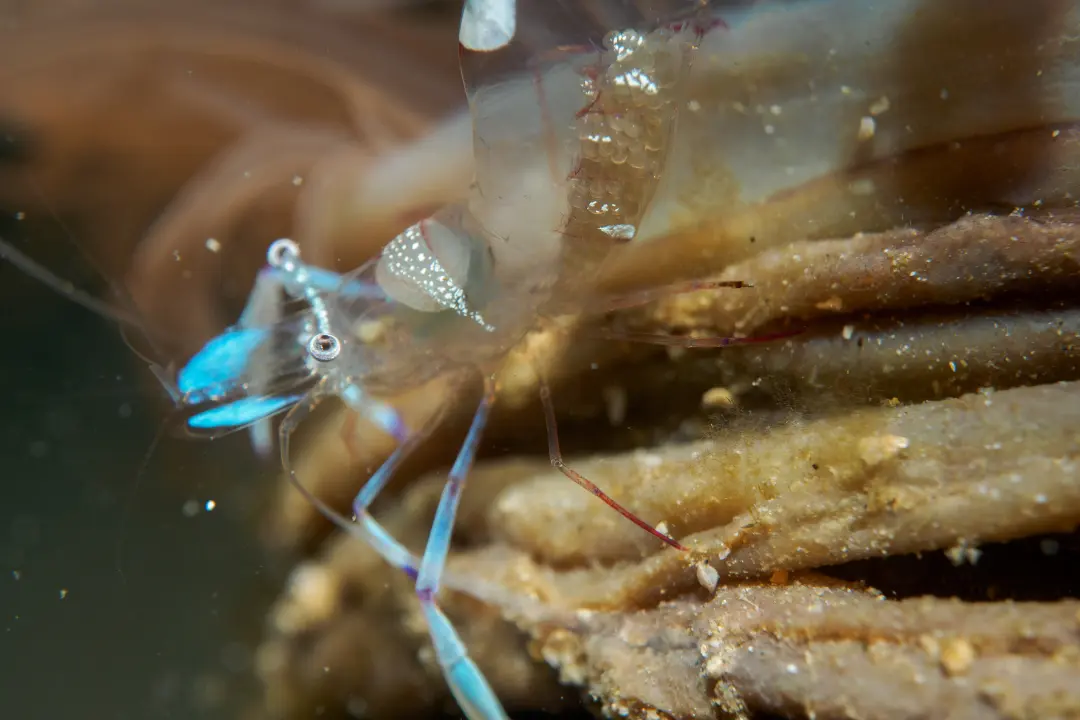
Ghost shrimps are not picky eaters, they can eat plants and small crustaceans. As discussed above, offer a mixed variety of feeds. Although they have an appetite, avoid overfeeding. It can lead to bad tank conditions.
We’ve made a quick care guide table only for you. Have a look!
Quick Care Guide
| Minimum Tank Size | 10 gallons (for a small group of shrimps) |
| Water PH | 7.0 to 8.0 |
| Water Temperature | 65°F to 82°F |
| Care Level | Easy care level |
| Maximum Size | 1.5 inches |
| Tank Mates | Yes (with small and peaceful fish) |
| Ghost shrimp diet | Omnivores |
Consider reading our expert opinions below to get a detailed overview. Learn what do you feed ghost shrimp and how to take good care.
Tank Size for ghost shrimps
It’s important to have the right-sized tank for our little ghostlings. The ideal ghost shrimp tank size is 10 gallons, which is enough for a couple of ghost shrimps, but larger sizes are good too. Although smaller tanks can be used, they might lead to tension and aggression.

To maintain the health of the shrimps, you must have a larger tank that maintains the right parameters. Adding more space allows beneficial bacteria to thrive and act as biofilters. Mimicking the natural habitat is vital. Having extra space means more plants and hiding spots which gives you an edge.
Ghost shrimps might be small but they are active creatures. A larger tank is good for them to swim around and interact with tank mates. Overall, investing in a moderate-sized tank is vital and good for the shrimpies.
Ideal Substrate for Ghost Shrimps
Ghost shrimps have delicate bodies. Always have a fine substrate in the tank to avoid injuries to our shrimpy friends. You should avoid sharp objects, rocks, plants, and substrate for this little cutie.

You should have a substrate depth of about 1 to 2 inches. This is ideal as it will provide space for them to burrow, sift in search of food, and play around. Moreover, it will be a stable base for plants.
Add some shrimp tank plants in the substrate as well, this provides a play area for the shrimps. Plants like java moss, java fern, and anubias, are some of our hand-picked favorites
Ghost shrimp water parameters
Temperature is one of the most crucial water parameters for shrimp survival. Let’s discuss the Ideal ghost shrimp aquarium parameters. The ideal ghost shrimp temperature is between 65°F to 82°F. Ghost shrimps are a bit sensitive to temperature changes as it can induce stress. Moreover, its immune system can be compromised due to water temperature changes.

Ghost shrimp originate from well-filtered freshwaters. you should use a water filter to maintain a lot of oxygen in the tank. Make sure the filter doesn’t make a lot of currents. Make sure the water is clean! Regular water changes of about 10 to 20 percent every week will be enough.
Let’s go a little further, I would recommend using a water test kit. Regularly check for water pH and other parameters. Consistent monitoring and maintenance will ensure a healthy and safe environment.
Tank mates for Ghost shrimps
Ghost shrimps are very peaceful, they don’t stand a chance of fighting someone. You should choose small fish that are very peaceful. Larger fish, especially of predatory nature must be avoided. If any fish sees the shrimp as food, they could disappear from the tank like poof! Magic.
You should have small snails like Nerites, with these beautiful ghosties. These snails can help the shrimp clean the tank and coexist. However, some snails like the apple snail can be quite aggressive. You should scratch them off the shrimp mates list as they pose a threat to the shrimp.
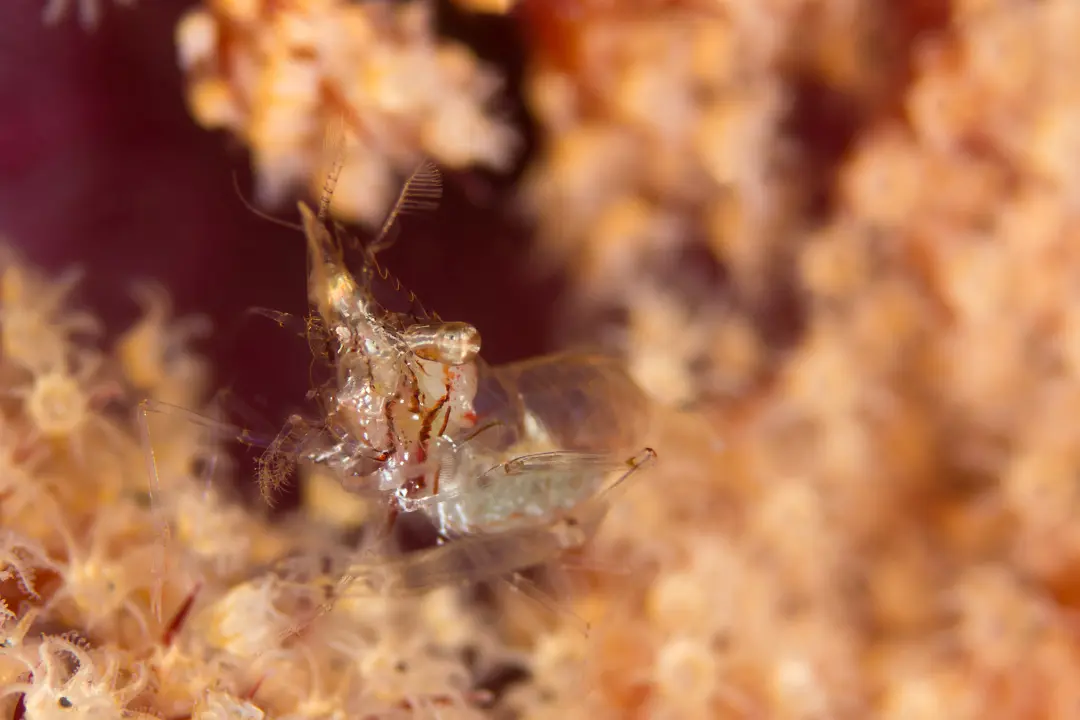
bottom-dwelling fish like loaches and corydoras catfish are best tankmates for shrimps as they are harmless. This way they will occupy different levels of the tank and thrive together. In case any aggression is observed, separate the fish to avoid shrimpy from stressing out.
It’s also important to check the compatibility of the tank mates with what you feed the ghost shrimp. What if the feed is harmful to them, consider all things like this before choosing tankmates.
Common Health Issues for Ghost Shrimps
Ghost shrimps are hardy creatures but they are prone to diseases while molting. You must be wondering: what’s ghost shrimp molting? do ghost shrimp shed? Yes, Molting is a process when ghost shrimp shed their hard exoskeleton to grow.
This process is not a big deal for them but can cause issues if not managed properly. Here we will discuss some of the common health issues. We know that you care for the little shrimpster, and knowing this info might help you prevent a disease!

Dead Shrimp:
If you are thinking, why did my shrimp die overnight? It’s because your ghost shrimp dies due to specific factors. Most of the time the shrimp dies due to bad water quality, high ammonia, and nitrite levels, what you feed your ghost shrimp, and stress. While molting, the shrimp might die because its immunity is a little low. Moreover, Exoskeleton deformities and improper shedding can cause this issue.
Be extra careful when your shrimp is molting and maintain the ideal tank Parameters. If your ghost shrimp has died then remove it from the tank as soon as possible to avoid further contamination.
New Shell:
When molting is completed, the shrimp get a new exoskeleton. This new shell is very soft and leaves the shrimp vulnerable to predators and disease. During this period make sure your shrimp has enough hiding space to avoid predators.
Separate the fish from aggressive tank mates and enrich them with a calcium diet. Some foods that are rich in calcium are discussed above.
Bacterial Infections:
Ghost shrimps are prone to bacterial infections. There could be many reasons like overcrowding, bad water conditions, and stress. some of the common symptoms are
- cloudy patches on the shrimp’s shell
- ghost shrimp turning white
- lethargy
- loss of appetite
- unusual behavior
To solve such problems, ensure the tank environment is optimal and the shrimp is happy. Maintain the perfect ghost shrimp diet and keep the tank clean. Special antibiotics and medications can be useful as well to treat infections.
FAQ’s
What are some good food options for ghost shrimp diet ?
Ghost shrimps aren’t picky eaters. Best foods include
- algae wafers
- shrimp pellets
- brine shrimp
- bloodworms
- small pieces of blanched vegetables (zucchini or spinach)
How often should I feed my ghost shrimp ?
You can feed your ghost shrimps once or twice a day but don’t overfeed them. Use small portions as overfeeding can lead to health and water quality issues.
Can ghost shrimp eat vegetables ?
Yes, ghost shrimp love vegetables. zucchini, spinach, and cucumber are the best food for shrimp although make sure they are blanched. If you’re still wondering what to feed your ghost shrimp then have a look at our article.
What is the lifespan of a ghost shrimp ?
Wondering: how long ghost shrimp live ? Ghost Shrimp’s lifespan can range anywhere between some day and a year. In some cases, they even live longer than a year. Soon after they are added to the tank, they are at risk of dying. This can happen due to an unsuitable tank environment. So, be extra careful when introducing it in a tank.
What is the best temperature for ghost shrimp ?
Ghost shrimp can tolerate a wide variety of water temperatures. However, the ideal water temperature is somewhere between 72-82°F.
What other creatures can live with ghost shrimp ?
Yes! Ghost shrimps are very peaceful and love to coexist with similar fish. Although, you must avoid aggressive fish as they are a threat to the shrimpy.
How long can ghost shrimp survive without food ?
Ghost shrimps can live for several days without food. However, it will affect their health severely. Make sure to feed them regularly.
Conclusion
Summing everything up, we explored the best ghost shrimp diet for a healthy shrimpy lifestyle. As omnivores, these freshwater wonders have an “easy to maintain” diet plan. However, you should maintain a balanced diet for optimal nutrition.
Offering the right diet promotes health and natural behavior in your pet shrimp. Having a mix of all sorts of foods mentioned above, you can delight your algae-loving shrimp. To treat them, add some vegetables to their dinner or breakfast. Don’t forget the water and tank conditions! they are equally important.
In essence, a well-planned diet will guarantee the long life of your pet. After all, you are what you eat! and the same goes for the ghost shrimps. Study the proper guidelines and diet instructions we have discussed and make a plan. Hit me up with what diet you’ve planned for your ghost shrimp!

